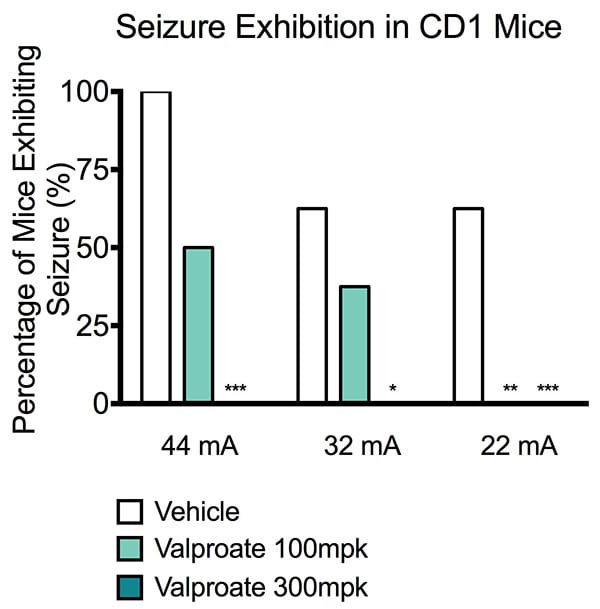6-Hz Psychomotor Seizure
Discover how Melior’s unique phenotypic screening platforms can uncover the untapped value of your candidate therapeutic
Epilepsy is a significant medical problem facing millions of people, most of who are not controlled by the current anticonvulsants on the market. Although a number of marketed anticonvulsant agents exist, there remains a high unmet medical need for better agents with reduced liability.
The 6 Hz Seizure Model is categorized as a partial or focal form of seizure (Psychomotor Seizure). This Psychomotor Seizure procedure is a model that tests a compound’s efficacy on the inhibition of certain forms of seizure. When characterizing anti-seizure candidates it an excellent screening complement to models of generalized seizure such as PTZ or MES.
In the current model, the effects of Valproate (100 and 300 mg/kg) as an anticonvulsant were tested against vehicle treated mice at differing currents of 22, 32 or 44 mA. The percentage of mice exhibiting seizure was examined.
Ready to get started or looking for a custom model?
Contact us today for more information about our bespoke research models and to discuss how we can help you answer your unique research questions.
Percentage of mice exhibiting clonus seizure activity. ICR-CD1 mice (n=8) were treated with either vehicle or Valproate (100 or 300 mg/kg) and administered a 6 Hz corneal stimulation with various currents (44 mA, 32 mA or 22 mA) fifteen minutes after treatment. Mice were monitored for fifteen seconds, post-shock administration, to determine if seizure activity was present.
Seizures were characterized as described in Kaminski et al., 2004 and Barton et al., 2001 and include locomotor agitation, a “stunned” posture associated with rearing (bipedal standing), forelimb automatic movements and clonus, twitching of the vibrissae, and Straub-tail. Data are mean ± SEM, 15 second time-out; *p<0.05, **p<0.01 and ***p<0.001 compared to vehicle.




 Interested in running a 6-Hz Psychomotor Seizure study?
Interested in running a 6-Hz Psychomotor Seizure study?